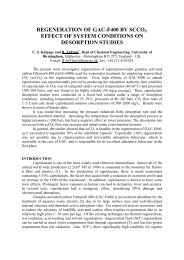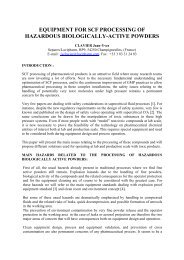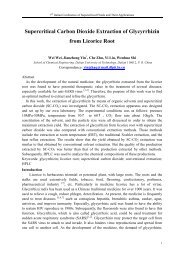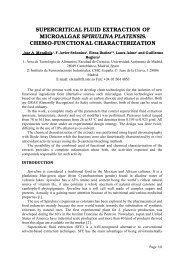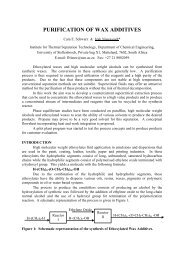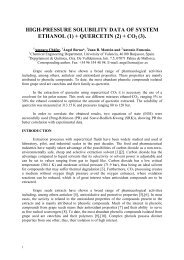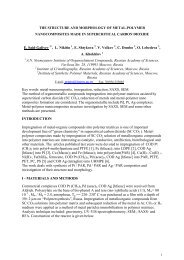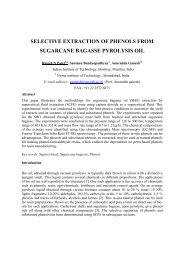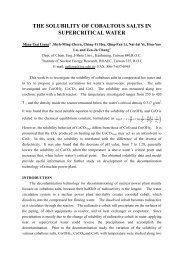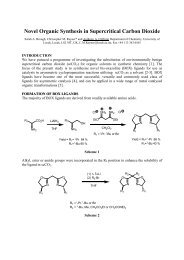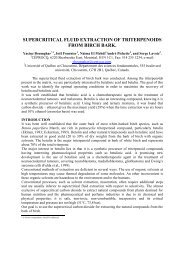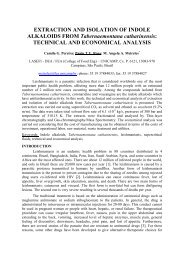continuous esterification in supercritical carbon dioxide - ISASF
continuous esterification in supercritical carbon dioxide - ISASF
continuous esterification in supercritical carbon dioxide - ISASF
Create successful ePaper yourself
Turn your PDF publications into a flip-book with our unique Google optimized e-Paper software.
CONTINUOUS ESTERIFICATION IN<br />
SUPERCRITICAL CARBON DIOXIDE<br />
Hassan S. Ghaziaskar* and Ali Daneshfar<br />
Department of Chemistry, Isfahan University of Technology<br />
Isfahan, 84154, I.R. Iran. Email: ghazi@cc.iut.ac.ir<br />
Heterogeneous <strong>esterification</strong> of 2-ethyl-1-hexanol and 2-ethyl hexanoic acid us<strong>in</strong>g<br />
AMBERLYST 15 as solid acid-catalyst <strong>in</strong> <strong>supercritical</strong> <strong>carbon</strong> <strong>dioxide</strong> (SC-CO 2 ) has been<br />
studied. Effect of pressure (150, 200, and 250 bar), temperature (75, 110, and 140 o C), flow<br />
rate of liquid CO 2 (0.4, 0.6, and 0.8 mL.m<strong>in</strong> -1 ) , type of sample collection, and mole ratio of<br />
alcohol to acid (2:1, 1:1, and 1:2) on ester yield have been studied. With <strong>in</strong>creas<strong>in</strong>g<br />
temperature from 75 to 110 o C the yield is <strong>in</strong>creased, but at 140 o C the yield is significantly<br />
decreased. The flow rate of SC-CO 2 and the mole ratio of the alcohol to the acid have no<br />
significant effect on the <strong>esterification</strong> yield.<br />
Introduction<br />
Supercritical <strong>carbon</strong> <strong>dioxide</strong> (SC-CO 2 ) is an attractive and suitable solvent for<br />
chemical reaction because of low T c and P c, non-toxicity, high diffusivity, pressure tunability,<br />
and ease of separation from products. Heterogeneous catalytic chemical reactions, <strong>in</strong> SC-CO 2,<br />
generally are performed us<strong>in</strong>g either a <strong>cont<strong>in</strong>uous</strong> flow reactor or a batch reactor [1]. There<br />
are many reactions that are carried out <strong>in</strong> <strong>cont<strong>in</strong>uous</strong> flow reactors such as dehydration [2],<br />
<strong>esterification</strong> [3], hydrogenation [4]. There are also many examples for batch processes such<br />
as polymerization [5] and <strong>esterification</strong> [6].<br />
Esterification reactions are equilibrium reactions that may be displaced to <strong>in</strong>crease<br />
product yield by choos<strong>in</strong>g excess amount of react<strong>in</strong>g materials, or remov<strong>in</strong>g products from<br />
reaction vessel but it may take many hours (>10h) to complete. Esterification reaction <strong>in</strong> SC-<br />
CO 2 offers some advantages over conventional processes such as: higher reaction rates,<br />
<strong>cont<strong>in</strong>uous</strong> removal of product(s), selective production of esters and free from solvent residue<br />
and f<strong>in</strong>al work-up processes.<br />
In this work, 2-ethyl-hexyl-2-ethyl hexanoate, 2E2E, was <strong>cont<strong>in</strong>uous</strong>ly synthesized<br />
from the <strong>esterification</strong> of 2-ethyl-1-hexanol and 2-ethyl hexanoic acid <strong>in</strong> the presence of<br />
AMBERLYST 15 as a solid-acid catalyst. The products were <strong>cont<strong>in</strong>uous</strong>ly extracted from<br />
catalyst bed by SC-CO 2 .<br />
Experimental Section<br />
(i) Materials. Carbon <strong>dioxide</strong> with purity of 99.5 mass% was purchased from ZamZam Co.<br />
Ltd. (Isfahan, Iran). 2-Ethyl-1-hexanol, 1-hexanol and n-hexane were purchased (with purity<br />
> 99%) from Merck Chemical Co. 2-Ethyl hexanoic acid was purchased from Tat Chemical<br />
Co. (purity > 99%) Isfahan, Iran. 2E2E and 2-ethyl hexyl ether (2EHE) were synthesized with<br />
purity of > 99% verified by GC.<br />
(ii) Apparatus and procedure. The <strong>esterification</strong> reaction was carried out us<strong>in</strong>g a<br />
<strong>cont<strong>in</strong>uous</strong> flow apparatus. In each experiment desired amount of 2-ethyl-1-hexanol and 2-<br />
ethyl hexanoic acid were placed <strong>in</strong> a 10 mL equilibrium cell and filled with glass beads <strong>in</strong><br />
order to decrease dead volume and <strong>in</strong>crease contact surface of solutes with SC-CO 2. The exit<br />
end of the equilibrium cell was connected to bottom (<strong>in</strong> order to prevent the channel<strong>in</strong>g<br />
effect) of catalyst bed (volume = 15 mL). The equilibrium cell and catalyst bed were placed <strong>in</strong><br />
1
an air oven and temperature was ma<strong>in</strong>ta<strong>in</strong>ed with<strong>in</strong> ±1 o C us<strong>in</strong>g a thermocouple controller<br />
device (Alton Ray Co., model TC14, Tehran. Iran).<br />
All experiments were performed at equilibrium and saturation conditions [7]. The<br />
liquid <strong>carbon</strong> <strong>dioxide</strong> was pressurized, by a JASCO model PU-980 reciprocat<strong>in</strong>g pump<br />
through a preheat<strong>in</strong>g coil <strong>in</strong> the oven, that enable CO 2 to reach oven temperature before<br />
enter<strong>in</strong>g the equilibrium cell. At the beg<strong>in</strong>n<strong>in</strong>g of each experiment, the system was ma<strong>in</strong>ta<strong>in</strong>ed<br />
at the desired temperature and pressure for at least 30 m<strong>in</strong>. The saturated SC-CO 2 passes<br />
through the catalytic bed, where chemical reactions take place and SC-CO 2 along with<br />
products and unreacted substrates was depressurized through a back-pressure regulator<br />
(JASCO, BP 1580-81). After the trap, the flow rate of expanded CO 2 gas was measured with<br />
wet gas meter (model W-NK-18, Sh<strong>in</strong>agawa, Japan). In all experiments Amberlyst 15 was<br />
used as catalyst. It was dried to constant weight before use <strong>in</strong> an air oven at 90 o C.<br />
(iii) Analytical Methods. In this work a modified trap as shown <strong>in</strong> Figure 1 was designed<br />
and used. The ma<strong>in</strong> parts of collection are a cool<strong>in</strong>g coil and a condenser. The coolant liquid<br />
(ethylene glycol) was circulated (LAUDA E104) <strong>in</strong> a coil. The coil and the collection vial (a<br />
two neck 5 mL flask) were submerged <strong>in</strong>to a 250 mL beaker that was filled with ethylene<br />
glycol, and the coolant was circulated around the condenser. The temperature of collection<br />
vial was –8 to –10 o C and the condenser temperature was set at -12 o C.<br />
The trapped mixture was transferred <strong>in</strong>to a volumetric flask and after addition of 1 mL<br />
1-hexanol, as an <strong>in</strong>ternal standard, the volume were made to 5 mL with n-hexane. The<br />
samples were analyzed with GC-TCD with a packed SE-30 column (Shimadzu Co. model<br />
GC-14A) us<strong>in</strong>g a temperature programm<strong>in</strong>g as follows: The <strong>in</strong>jection port and the detector<br />
temperature of GC were set at 240 o C and 250 o C respectively. The column temperature was<br />
programmed as zero m<strong>in</strong>. at 50 o C, 0 m<strong>in</strong> at 90 o C, and 10 m<strong>in</strong> at 240 o C with the temperature<br />
ramp of 6 o C. m<strong>in</strong> -1 and 40 o C .m<strong>in</strong> -1 , respectively.<br />
2E2E and 2EHE were determ<strong>in</strong>ed by external calibration and alkene was determ<strong>in</strong>ed<br />
based on mass balance of <strong>in</strong>itial mole of 2-ethyl-1-hexanol. The yield of 2E2E was calculated<br />
based on number of reacted moles of 2-ethyl hexanoic acid. The yields of 2EHE and alkene<br />
were calculated based on <strong>in</strong>itial mole of 2-ethyl-1-hexanol.<br />
Results and Discussions<br />
In our previous works [8] it was shown that the solubility of 2-ethyl-1-hexanol and 2-<br />
ethyl hexanoic acid <strong>in</strong> SC-CO 2 , for a 1:1 molar ratio of alcohol to acid <strong>in</strong> the equilibrium cell,<br />
were similar. This co-solubility may be due to the existence of <strong>in</strong>termolecular hydrogen<br />
bond<strong>in</strong>g between molecules of 2-ethyl-1-hexanol and 2-ethyl hexanoic acid. Moreover similar<br />
solubility was ma<strong>in</strong>ta<strong>in</strong>ed versus time [7].<br />
In this work the concept of co-solubility was used to perform chemical reaction <strong>in</strong> SC-<br />
CO 2 . The SC-CO 2 dissolves 2-ethyl-1-hexanol and 2-ethyl hexanoic acid and then passes<br />
through the heterogeneous catalyst where dehydration, etherification and <strong>esterification</strong><br />
reactions may take place.<br />
The effect of the temperature on product yield is shown <strong>in</strong> Table 1. Rais<strong>in</strong>g the<br />
temperature from 75 to 110 o C <strong>in</strong>creases the conversion and the product yields. With further<br />
<strong>in</strong>crease <strong>in</strong> temperature from 110 to 140 o C a significant reduction <strong>in</strong> conversion of alcohol<br />
and acid to ester takes place. That might be due to catalyst deactivation [2] or desulfonation.<br />
The effect of pressure on the <strong>esterification</strong> was also studied <strong>in</strong> the pressure range of<br />
150 to 250 bar (Table 2). At higher pressures the solubility of 2-ethyl-1-hexanol and 2-ethyl<br />
hexanoic acid and the residence time over the catalyst are <strong>in</strong>creased [2]. The yield of<br />
<strong>esterification</strong> reaction is approximately constant and <strong>in</strong>dependent of pressure. This behavior<br />
2
may be due to the fact that <strong>in</strong> the pressures beyond 180 bars solubility of 2-ethyl-1-hexanol<br />
and 2-ethyl hexanoic acid rema<strong>in</strong>s constant and rais<strong>in</strong>g the pressure has no effect on their<br />
solubility [9]. Therefore <strong>in</strong> the <strong>esterification</strong> reaction <strong>in</strong>crease <strong>in</strong> pressure do not have any<br />
effect on the solubility of the acid and the alcohol.<br />
The effects of variation of the molar ratio (r) of 2-ethyl-1-hexanol to 2-ethyl hexanoic<br />
acid from 1:2 to 2:1 are shown <strong>in</strong> Table 3. With <strong>in</strong>creas<strong>in</strong>g the molar ratio, the yield of 2E2E<br />
and 2EHE are changed slightly. This shows that the <strong>esterification</strong> reaction is controlled by 2-<br />
ethyl hexanoic acid protonation. Increas<strong>in</strong>g the amount of 2-ethyl-1-hexanol promotes the<br />
alcohol protonation and <strong>in</strong>creases the yield of 2EHE and alkene formation.<br />
The effect of liquid CO 2 flow rate on <strong>esterification</strong> reaction was also studied. There<br />
are no significant changes <strong>in</strong> the substrates conversion and product yields. This is because of<br />
low and similar solubilities of the alcohol and the acid at 150 bar and 110 o C [9].<br />
The reusability of Amberlyst 15 was also studied and the results are shown <strong>in</strong> Table 4.<br />
After each run the catalyst was washed with methanol, dried <strong>in</strong> an oven at 90 o C up to<br />
constant weight. The results show that the yield of 2E2E formation decreases <strong>in</strong> later run.<br />
To <strong>in</strong>vestigate the effect of sample trapp<strong>in</strong>g method, a purge test was performed and<br />
the results are shown <strong>in</strong> Table 5. The purge test was performed with (1) n-hexane solvent, (2)<br />
glass beads, (3) glass beads and n-hexane with modified sample trapp<strong>in</strong>g (Figure 1). The<br />
results show that by solvent collection the loss due to aerosol formation significantly are<br />
reduced. The aerosol formation is very significant <strong>in</strong> glass beads sample trapp<strong>in</strong>g method and<br />
the loss <strong>in</strong> the trapped sample is about 40% for the alcohol and 30% for the acid and the ester.<br />
But <strong>in</strong> modified methods the loss of the test materials is very small (5% for alcohol and 4%<br />
for acid and ester). The efficiency of the reactant(s) and product(s) trapp<strong>in</strong>g are listed <strong>in</strong> Table<br />
5. The modified system can trap acid, alcohol, and ester with the same trapp<strong>in</strong>g efficiencies.<br />
There are many factors that reduce ester yield <strong>in</strong> <strong>cont<strong>in</strong>uous</strong> flow system such as removal of<br />
unreacted acid from catalytic bed due to high solubility of 2-ethyl hexanoic acid <strong>in</strong> SC-CO 2<br />
[10] and dehydration of alcohol <strong>in</strong> the presence of strong solid-acid catalyst that converts the<br />
alcohol to alkene and promotes ether formation (as side reactions). We are work<strong>in</strong>g to<br />
improve these drawbacks and modify the system.<br />
Conclusion<br />
The <strong>cont<strong>in</strong>uous</strong> <strong>esterification</strong> reaction was performed <strong>in</strong> SC-CO 2 . The benefits of the<br />
<strong>cont<strong>in</strong>uous</strong> <strong>esterification</strong> <strong>in</strong> SC-CO 2 are easy separation of product(s) from solvent and<br />
unreacted materials, smaller reactors, and milder condition were experienced. Our results<br />
show that due to high solubility of 2-ethyl hexanoic acid <strong>in</strong> SC-CO 2 it is removed from the<br />
bed and the yield can not be improved from the catalytic bed. The dehydration of 2-ethyl-1-<br />
hexanol and its etherification to 2EHE are the ma<strong>in</strong> side products that reduce the ester yield.<br />
The modified trap has significantly lowered the aerosol formation and <strong>in</strong>creased the trapp<strong>in</strong>g<br />
efficiency to prevent the sample loss<br />
3
References<br />
[1] Baiker, A. Supercritical Fluids <strong>in</strong> Heterogeneous Catalysis. Chem. Rev., Vol. 99, 1999,<br />
753.<br />
[2] Gary, W. K., Smail, F. R., Hitzler, M. G., Ross, S. K., Poliakoff, M., J. Am. Chem. Soc.<br />
Vol. 121, 1999, P. 10711.<br />
[3] Brown, J. S., Lesutis, H. P., Lamb, D. R., Bush, D., Chandler, K., West, B. L., Liotta, C.,<br />
Eckert, C. A., Schiraldi, D., Hurley, J. S., Ind. Eng. Chem. Res., Vol. 38, 1999, P. 3622.<br />
[4] Jossop, P. G., Hsiao, Y., Ikariya, T., Noyori, R., J. Am. Chem. Soc., Vol. 118, 1996, P.<br />
344.<br />
[5] Ikushima, Y., Hatakeda, K., Ito, S., Saito, N., Asano, T., Goto, T., Ind. Eng. Chem. Res.,<br />
Vol. 27, 1998, P. 818.<br />
[6] Vieville, C., Mouloungui, Z., Gaset, A.,. Ind. Eng. Chem. Res., Vol. 32, 1993, P.2065.<br />
[7] Ghaziaskar, H. S., Daneshfar, A., J. Supercrit. Fluids, vol. 25, 2003, p.1.<br />
[8] Kendall, J. L., Canelas, D. A., Yong, J. L., Desimone, J. M.,. Chem. Rev., Vol. 99, 1999,<br />
P.543.<br />
[9] Ghaziaskar, H. S., Eskandari, H., Daneshfar, A., J. Chem. Eng. Data, 2003 <strong>in</strong> press.<br />
[10] Burk, M. J., Feng, S., Gross, M. F., Tumas,W., J. Am. Chem. Soc., Vol. 117, 1995, P.<br />
8277.<br />
Cool<strong>in</strong>g liquid<br />
exit<br />
Thermometer<br />
CO 2 out<br />
SC-CO 2 + Solutes<br />
Cool<strong>in</strong>g liquid<br />
entrance<br />
Liquid<br />
Figure 1. Modified trap<br />
4
Table 1. Cont<strong>in</strong>uous Synthesis of 2E2E from 2-Ethyl-1-hexanol + 2-Ethylhexanoic Acid<br />
<strong>in</strong> SC-CO 2 at different temperatures a<br />
T ( o C) Yield (%)<br />
2E2E 2EHE Alkene<br />
75 15.20 ND b 65.00<br />
110 27.38 1.57 70.52<br />
140 0.24 0.91 98.85<br />
a Other reaction conditions: Amberlyst 15 as catalyst; 15 mL reactor; flow rate of CO 2 = 0.4<br />
mL/m<strong>in</strong>; pressure of 150 bar; alcohol to acid ratio of 1.0. b Not detectable.<br />
Table 2. Cont<strong>in</strong>uous Formation of 2E2E from 2-Ethyl-1-hexanol + 2-Ethylhexanoic Acid<br />
<strong>in</strong> SC-CO 2 at different pressures a<br />
P (bar) Yield (%)<br />
2E2E 2EHE Alkene<br />
150 22.51 2.08 75.00<br />
200 21.00 2.00 77.00<br />
250 27.38 2.92 69.70<br />
a Other reaction conditions: Amberlyst 15 as catalyst; 15 mL reactor; flow rate of CO 2 = 0.4<br />
mL/m<strong>in</strong>; Temperature of 75 o C; alcohol to acid mole ratio of 1.0.<br />
Table 3. Cont<strong>in</strong>uous Formation of 2E2E from 2-Ethyl-1-hexanol + 2-Ethylhexanoic Acid<br />
<strong>in</strong> SC-CO 2 at different Alcohol to Acid Ratios a<br />
r Yield (%)<br />
2E2E 2EHE Alkene<br />
1.0 22.51 2.08 75.00<br />
2.0 31.90 11.55 68.50<br />
0.5 24.63 3.37 71.37<br />
a<br />
Other reaction conditions: Amberlyst 15 as catalyst; 15 mL reactor; flow rate of CO 2 = 0.4<br />
mL/m<strong>in</strong>; at 150 bar and 110 o C; alcohol to acid mole ratio of 1.0.<br />
5
Table 4. Cont<strong>in</strong>uous Formation of 2E2E from 2-Ethyl-1-hexanol + 2-Ethylhexanoic Acid<br />
<strong>in</strong> SC-CO 2<br />
a<br />
Catalyst Yield (%)<br />
2E2E 2EHE Alkene<br />
Fresh 22.51 2.08 75.00<br />
Recovered 17.97 4.56 77.47<br />
a Other reaction conditions: Amberlyst 15 as catalyst; 15 mL reactor; CO 2 flow rate of 0.4<br />
mL/m<strong>in</strong>; at 150 bar and 110 o C; the alcohol to the acid ratio of 1.0<br />
Table 5. The Result of Purge Test<br />
Purge Recovery (%)<br />
2-Ethyl-1-hexanol<br />
2-Ethyl hexanoic acid 2E2E<br />
1 a 89.38 94.51 93.56<br />
2 b 66.48 72.10 71.37<br />
3 c 94.61 96.80 95.69<br />
a Trapped us<strong>in</strong>g n-hexane; b Trapped on the glass beads; c Trapped on the glass beads and n-<br />
hexane with the modified method; CO 2 flow rate of 0.6 mL/m<strong>in</strong>; at 150 bar and 110 o C; purge<br />
time of 6 h.<br />
Table 6. Cont<strong>in</strong>uous Formation of 2E2E from 2-Ethyl-1-hexanol + 2-Ethylhexanoic Acid<br />
<strong>in</strong> SC-CO 2 Us<strong>in</strong>g Different Collection Methods a .<br />
Collection Yield (%)<br />
Method<br />
2E2E 2EHE Alkene<br />
1 b 22.27 3.14 74.10<br />
2 c 24.41 4.29 71.29<br />
3 d 22.30 3.96 70.83<br />
a Other reaction conditions: Amberlyst 15 as catalyst; 15 mL reactor; CO 2 flow rate of 0.6<br />
mL/m<strong>in</strong>; at 150 bar and 110 o C; the alcohol to the acid ratio of 1.0. b Trapped over glass beads.<br />
c Trapped <strong>in</strong> n-hexane solvent. d Trapped over glass beads, n-hexane and the modified system.<br />
6



